

The Swastika
Dispersion of the Swastika
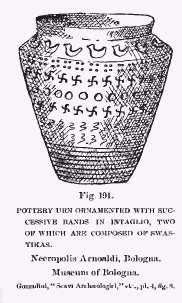 peculiar
in shape and decoration, but is typical of that epoch. The decoration
was by stamps in the clay (intaglio) of a given subject repeated in the
narrow bands around the body of the vase. Two of these bands were of small
Swastikas with the ends all turned to the right. Fig. 192 shows a fragment
of pottery from the Felsina necropolis, Bologna, ornamented with a row
of Swastikas stamped into the clay in a manner peculiar to the locality.
peculiar
in shape and decoration, but is typical of that epoch. The decoration
was by stamps in the clay (intaglio) of a given subject repeated in the
narrow bands around the body of the vase. Two of these bands were of small
Swastikas with the ends all turned to the right. Fig. 192 shows a fragment
of pottery from the Felsina necropolis, Bologna, ornamented with a row
of Swastikas stamped into the clay in a manner peculiar to the locality.Fig. 193 shows the end view of one of the bobbins from Bologna, Italy, in the possessions of Count Gozzadini by whom it was collected. The decoration on the end, as shown by the figure, is the Swastika. The main arms are made up of three parallel lines, which intersect each other at right angles, and which all turn to the right at right angles. The lines are not incised, as is usual, but, like much of the decoration belonging to this culture, are made by little points consecutively placed, so as to give the appearance of a continuous line.
Swastikas turning both ways are on one or both extremities of many terra-
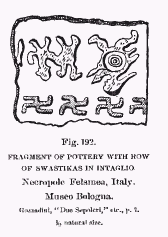 cotta
cylinders found in the terramare at Coazze, province of Verona, deposited
in the National (Kircheriano) Museum at Rome. (See figs. 380 and 381 for
similar bobbins. [Transcribers note: These illustrations were not included
in the text.)
cotta
cylinders found in the terramare at Coazze, province of Verona, deposited
in the National (Kircheriano) Museum at Rome. (See figs. 380 and 381 for
similar bobbins. [Transcribers note: These illustrations were not included
in the text.)The museum at Este, Italy, contains an elegant pottery vase of large dimensions, represented in fig. 194, the decoration of which is the Greek fret around then neck and the Swastika around the body, done with small nail heads or similar disks inserted in the clay in the forms indicated. This association of the Swastika and the Greek fret on the same object is satisfactory evidence of their contemporaneous existence, and is thus far evidence that he one was not derived form the other, especially as the authorities who claim this derivation are at variance as to which was parent and which, child. (See fig. 133.)
A Swastika of the curious half-spiral form turned to the left, such as has been
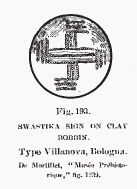
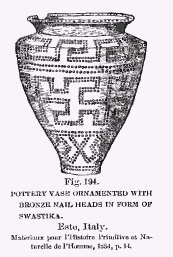

found in Scandinavia and also among the Pueblo Indians of the United States, as in the museum at Este.
When in the early centuries of the Christian era the Huns made their irruption into Europe, they apparently possessed a knowledge of the Swastika. They settled in certain town of northern Italy, drove off the inhabitants, and occupied the territory for themselves. On the death of Attila and the repulse of the Huns and their general return to their native country, many small tribes remained and gradually became assimilated with the population. They have remained in northern Italy under the title of Longobards. In this Longbardian civilization or barbarism, whichever we may call it, and in their style of architecture and ornament, the Swastika found a prominent place, and is spoken of as Langobardian.
It is needless to multiply citations of the Swastika in Roman and Christian
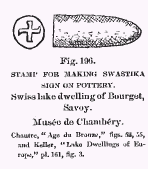 times.
It would appear as though the sign had descended from the Etruscans and
Samnites along the coast and had continued us use during Roman times.
Schliemann says (1) that it is
found frequently in the wall paintings at Pompeii; even more than a hundred
times in a house in the recently excavated street of Vesuvius. It may
have contested with the Latin cross for the honor of being the Christian
cross, for we know that the St. Andrew's cross in connection with the
Greek letter P (figs. 6) did
so, and for a long time stood as the monogram of Christ and was the Labarum
of Constantine. All three of these are on the base of the Archiepiscopal
chair in the cathedral at Milau. (2)
times.
It would appear as though the sign had descended from the Etruscans and
Samnites along the coast and had continued us use during Roman times.
Schliemann says (1) that it is
found frequently in the wall paintings at Pompeii; even more than a hundred
times in a house in the recently excavated street of Vesuvius. It may
have contested with the Latin cross for the honor of being the Christian
cross, for we know that the St. Andrew's cross in connection with the
Greek letter P (figs. 6) did
so, and for a long time stood as the monogram of Christ and was the Labarum
of Constantine. All three of these are on the base of the Archiepiscopal
chair in the cathedral at Milau. (2)Swiss lake dwellings. --- Figs. 195 and 196 are interesting as giving an insight into the method of making the sign of the Swastika. Fig. 195 shows a fragment of pottery bearing a stamped intaglio Swastika (right), while fig. 196, represents the stamp, also in pottery, with which the imprint was made. They are figured by Keller, (3) and are described on page 339, and by Chantre. (4) They were found in the Swiss lake dwelling of Bourget (Savoy) by the Duc de Chaulnes, and are credited to his Museum of Chambery.
ENDNOTES:
1. "Ilios," p. 352. [Back]
2. There are bronze hatchets from Italy, with Swastikas in intaglio and in relief, in Musée St. Germain. De Mortillet, "Musée Préhistorique," figs. 1153, 1154. Back
3. "Lake Dwellings," pl. 161, figs. 3, 4. Back
4. "Age du Bronze," pt. 2, figs. 53-55, p. 195. Back
<< Previous Page Next Page >>
© 2004-2007 Northvegr.
Most of the material on this site is in the public domain. However, many people have worked very hard to bring these texts to you so if you do use the work, we would appreciate it if you could give credit to both the Northvegr site and to the individuals who worked to bring you these texts. A small number of texts are copyrighted and cannot be used without the author's permission. Any text that is copyrighted will have a clear notation of such on the main index page for that text. Inquiries can be sent to info@northvegr.org. Northvegr™ and the Northvegr symbol are trademarks and service marks of the Northvegr Foundation.

|